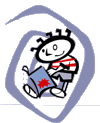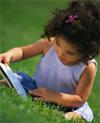 |
 |
 |


|
If you don’t look closely at the cover of The Encyclopedia of Infant and Toddler Activities, you might miss something important: underneath the title it says, in smaller print “written by teachers for teachers.” While this is great if you’re a teacher and have a classroom full of infants or toddlers, it isn’t so wonderful if you’ve gotten the book for use at home with your own child. Some of the sections of the book, such as Arrival (to be used when children first enter the classroom), will either be useless for those who are using the book at home or will have to be heavily modified. Other sections, such as Discovery, Science and Fine and Gross Motor Skills, are more useful, but some of them will only be successful if you have a group of children involved.
If you are a teacher, you will probably find a lot to love in this large book. There are plenty of activities ranging from simple (standing in front of an infant with another adult and talking back and forth so the infant follows your voices) to more complicated (craft projects with materials, for example). This book might be especially useful for those caregivers who watch infants and young toddlers and might not know what activities can be helpful for children this young. However, the book would benefit from a few more pictures, especially with those activities that revolve around crafts. There are only a few hand-drawn pictures, and these easily could have been expanded upon.
Those who are using the book at home will not find the book without its uses. There are still plenty of activities that you can use with a single child or a few children if you have more than one—some with a few simple modifications and some without even that. These might also spark some ideas for “play dates” or parties that you will hold at your home.
The Encyclopedia of Infant and Toddler Activities is a great book for those who teach classrooms full of infants and toddlers. And, while it is still useful for those who want to use it at home with their children, this group of adults might find more use for a book that is not written for teachers.
|







|
| |
Angela McQuay/2006 for curled
up with a good kid's book |
|
|
For grown-up fiction, nonfiction and speculative fiction book reviews,
visit our sister site Curled Up With a Good Book (www.curledup.com)
|
|